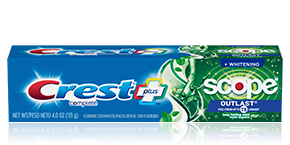My toothpaste is giving me a headache.
Not a physical ache, but a frustration ache that comes from meaning to buy one variety and mistakenly buying another. My husband Dan has this headache too.
Dan’s office is a block away from our closest Target store. I’ve been a beneficiary of this proximity as he consistently offers to do our shopping there.
Dan is a meticulous shopper and cares about getting the purchases right, having me send a photo of the product I want. But even a photo has not solved this problem.
The photo I sent looked like the image on the left. What he brought home was the image on the right. Seriously, can you tell the difference?
They are both Crest Complete Whitening Plus Scope toothpastes. The one on the right has “Outlast.”
Outlast indeed. Crest’s website describes Outlast this way:
“Revolutionary technology provides a cool, fresh breath feeling that last up to 7x longer vs. ordinary toothpaste.”
To get the 7x longer, Crest has turbocharged the mint to industrial strength. As in clears-your-sinuses, keeps-you-awake-20-minutes-longer mint.
The similar packages have resulted in wrong purchases three times now. I’ve stopped returning them. The thought I have to put into directing Dan, the frustration of getting the wrong one, the bother to exchange products and my mind-blowing-mint sleep delay are more time and effort than toothpaste should take.
Why Choosing Toothpaste Has Gotten So Hard
When describing the toothpaste I wanted to Dan, all I remembered was that it was Crest Complete and had Scope in it.
On Crest’s website I found seven toothpastes that fit that description. I counted 35 varieties of toothpaste in total, not including kids’ varieties, depending on whether you want to whiten your teeth, protect your enamel, clean and freshen, manage gum sensitivity or protect your teeth all around.
Who wants to make trade-offs between whitening their teeth and protecting their enamel and cleaning and freshening? Who has time to contemplate this?
The proliferation of toothpaste varieties comes from the misguided perception that more choice is better than less. As Professor Barry Schwartz from Swarthmore College explains in his book, The Paradox of Choice, our societal belief is that maximizing choice is a way to maximize freedom.
For societies lacking sufficient resources and choices, this is true.
But for affluent Western societies this belief has backfired on us. We have so many choices – of toothpaste, television sets, breakfast cereal, pretty much any consumable you can think of – that our great level of choice has produced two negative effects.
How More Choice Can Backfire
First, it produces paralysis. With so many options, people find it hard to choose. They fear making the wrong choice. Some people become demotivated and forgo the choice altogether.
In a famous study reported in 2000, Professor Sheena Iyengar at Columbia University Business School and Professor Mark Lepper at Stanford University Business School tested two scenarios at Draegars supermarket in California. Draegers was known for having an extensive selection of everything it offered, including 250 varieties of mustard, 75 varieties of olive oil and 300 varieties of jam. This study exposed shoppers to a tasting booth of either 6 jams or 30 jams.
Sixty percent of the shoppers passing the booth with 30 jams approached it, but only 40 percent of the shoppers exposed to the 6-jam table approached. However, 30 percent of the customers who experienced the limited selection made a purchase, but only 3 percent of the customers exposed to the extensive-choice made a purchase.
The 6-jam tasting booth resulted in sales to 12 percent of the customers who experienced it, while the 30-jam tasting booth generated sales to just 1.8 percent of its customers.
Professor Iyengar has replicated this kind of choice study with chocolates and even with 401(k) plan contributions. In the latter case, for every 10 funds added to employees’ choices, 401(k) plan participation fell 1.5 to 2 percent.
Plans offering only two choices had a 75 percent participation rate, while for those offering 59 choices participation dropped to 60 percent. Plans that offered fewer than 10 choices had significantly higher participation rates than those that offered 10 or more.
Choosing was such a headache for employees offered the 10+ choice plans that not only did they not participate but they forewent their employers matching contribution.
The second negative effect of too much choice is an overall decrease in satisfaction from choosing.
With so many choices available, people’s expectations rise. They surmise one of the choices must be perfect.
If the one they choose isn’t perfect, they experience dissatisfaction even if their choice was fine. They imagine there must have been a better choice available and they failed to opt for it. They blame themselves.
This sentiment is the force behind Campbell’s long-running campaign for their vegetable juice line: “I could have had a V8!”
When Does More Choice Hurt?
In 2015 researchers Alexander Chernev, Ulf Böckenholt and Joseph Goodman at Northwestern University’s Kellogg School of Management re-analyzed data for 99 Paradox of Choice studies to identify when reducing choices for customers would likely increase sales. They found four scenarios:
- When people want to minimize the effort to choose, especially for “low involvement products,” products they purchase regularly that don’t affect their lifestyle and are low cost. Hello toothpaste!
- When people are unclear about their preferences because the product category is new to them. If I was shopping for a Virtual Reality headset, I would be in this scenario.
- When the product is complex, so that choosing is difficult and making the right choice is important. I experienced this last May when I was looking for a new printer-scanner-copier.
- When the category is complex, so that comparing options is difficult. Comparing different cars with different accessory packages qualifies here.
What the Paradox of Choice Means for Your Brand
The paradox of choice creates consumer agita like the frustration I have from my toothpaste saga. But I’m not frustrated with society. I’m unhappy with Crest. I blame them for making this hard.
We work hard to make our brands attractive to our target audiences. The last thing we want is to aggravate customers or to make buying from us harder.
To have your brand avoid choice overload and ease your customers’ experience:
- Determine if your brand’s offerings fall into one of the four categories above. Do this by category analysis but also by talking to your customers to understand their buying process. What prompts them to get in buying mode? How do they consider their options? What factors help them decide? What would make it easier for them?
- Simplify your selection. Align offerings with your niche, which will reinforce it. Make your offerings distinct and meaningful. Adjust based on customer requests and feedback. If you sell services, simplifying might mean creating packages that replicate the bundle of services your customers frequently buy together.
- Communicate offerings clearly. Use consumer language whenever possible in your product descriptions. Group offerings logically. Use white space on your website to make seeing and comprehending your offerings easy. Color code varieties of the same item on packages and on your website. Make varietal descriptions prominent and easy to read.
- Take away the risk of purchase. Offer a generous return period and free shipping. If you sell a service, offer a free trial period, a money-back guarantee or free helpful content (newsletter, white paper, infographic) that helps your customers increase their confidence that purchasing from you is the right move.
Make doing business with your brand easy and your business will grow.
I’m still working my way through the tube of oppressive toothpaste, but I did apply Barry Schwartz’s advice to avoid excessive choice recently when it came time to replace my sneakers.
Do you have any idea how many women’s sneaker offerings there are?
A search on Zappos.com of women’s size 8 sneakers yielded 9521 items. Talk about overload!
But Zappos allows you to cull your search several ways. I looked for the updated model of the brand I had before. I ordered two pairs with colors that I liked and kept one of them.
Are the sneakers perfect? No. But I don’t need perfection in sneakers. Just comfort, support and visual appeal.
I’ll save my emotional energy for more important investments, like considering where Dan and I should travel to celebrate our 25th wedding anniversary.
Any suggestions, or shopping horror stories?
If you liked this post, you’ll love the next one.
To have future posts sent to your inbox...




Excellent piece. Completely agree, and I was thinking after the first paragraph about the paradox of choice and that is exactly where you went. Congrats. And speaking of where you go, we did Italy on our 25th. Rome, Florence, Venice and it was great!
Thanks Jill, for the accolades and for sharing your 25th anniversary itinerary to Italy! We did a similar trip 20 years ago, not attached to an anniversary. We are mulling Portugal so far.